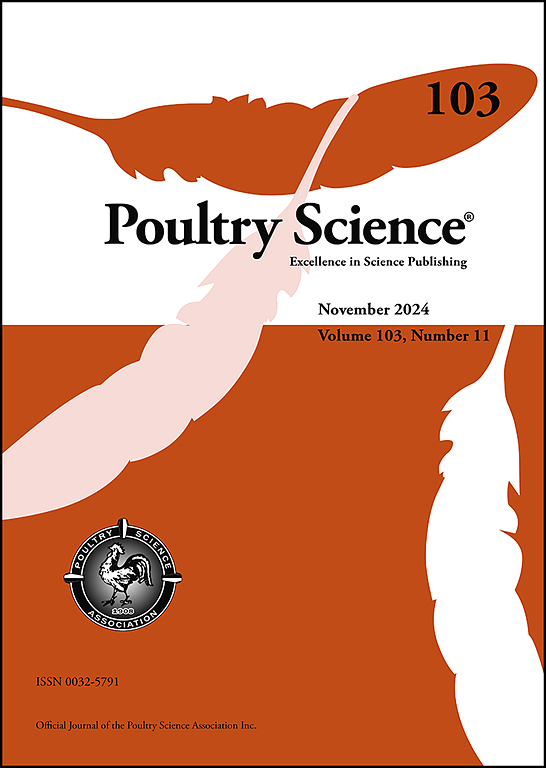The influence of genetic strain on fear and anxiety responses of laying hens housed in a cage-free environment
IF 3.8
1区 农林科学
Q1 AGRICULTURE, DAIRY & ANIMAL SCIENCE
引用次数: 0
Abstract
Cage-free environments provide more behavioral opportunities for hens than cages, but fear responses in such open housing can lead to injuries and challenging human-animal interactions. This study evaluated the impact of genetic strain on fear and anxiety responses in two brown and one white genetic strain of laying hens: Hy-Line Brown (HB), Bovan Brown (BB), and H&N White (HN). Hens were assessed at the start of lay and peak lay through the inversion and attention bias tests, along with thermal imaging and core body temperature measurements to assess stress-induced hyperthermia. During the inversion test, HB hens performed significantly more wing flaps than other strains (p=0.012), while BB hens exhibited more vocalizations than HN hens (p=0.0041). Thermal imaging revealed that at the start of lay, HB and HN hens had higher maximum comb temperatures than BB hens (p<0.0001), but HB hens had lower temperatures at peak lay (p=0.027). BB and HN hens had higher core body temperatures at 4- and 5-minutes post-inversion (p<0.0001). In the attention bias test, HB and BB hens were more likely to resume eating and showed increased head bobbing as they aged, whereas HN hens were less likely to resume eating but maintained high head bobbing (p=0.017; p=0.00056). BB hens had the lowest average eye and maximum comb temperatures 3.5 to 4.5 min post-startle at the start of lay (p<0.05), white HN hens had the highest average eye and comb temperatures (p<0.0001) and higher average eye temperatures than BB at peak lay (p=0.026). Finally, HN hens had higher core body temperatures than HB hens at both the start of lay and peak lay (p=0.041; p=0.046). These results indicate that brown and white strains differ in their responses to fear and anxiety, with brown strains being more behaviorally responsive and white strains showing greater physiological stress. These strain-specific coping mechanisms provide insight into how hens may react to stressors in cage-free environments, aiding in strain selection for producers.
遗传品系对无笼环境下蛋鸡恐惧和焦虑反应的影响
与笼子相比,无笼环境为母鸡提供了更多的行为机会,但在这种开放的环境中,恐惧反应可能导致伤害和挑战人与动物的互动。本研究评价了遗传品系对两种棕色和一种白色蛋鸡遗传品系:海兰褐(HB)、博凡褐(BB)和汉恩白(HN)的恐惧和焦虑反应的影响。通过倒置和注意偏差测试,以及热成像和核心体温测量来评估母鸡在产蛋开始和产蛋高峰时的体温。倒置试验中,HB蛋鸡扇动翅膀的次数显著高于其他品系(p=0.012), BB蛋鸡发声次数显著高于HN蛋鸡(p=0.0041)。热成像结果显示,在产蛋初期,HB和HN蛋鸡的最高鸡冠温度高于BB蛋鸡(p= 0.0001),而HB蛋鸡的最高鸡冠温度低于BB蛋鸡(p=0.027)。BB和HN蛋鸡在倒伏后4和5分钟的核心体温较高(p<0.0001)。注意偏倚试验中,HB和BB蛋鸡随着年龄的增长,恢复进食的可能性更大,且随着年龄的增长,头摇的次数增加,而HN蛋鸡恢复进食的可能性更小,但保持较高的头摇(p=0.017;p = 0.00056)。BB蛋鸡产蛋后3.5 ~ 4.5 min平均眼温和最高鸡冠温度最低(p < 0.05),白HN蛋鸡产蛋高峰期平均眼温和鸡冠温度最高(p < 0.0001),平均眼温高于BB蛋鸡(p < 0.026)。最后,在产蛋初期和产蛋高峰期,HN蛋鸡的核心体温均高于HB蛋鸡(p=0.041;p = 0.046)。这些结果表明,棕色菌株和白色菌株对恐惧和焦虑的反应不同,棕色菌株表现出更强的行为反应,而白色菌株表现出更大的生理应激。这些菌株特异性应对机制提供了母鸡在非笼养环境中如何对压力源作出反应的见解,有助于生产者选择菌株。
本文章由计算机程序翻译,如有差异,请以英文原文为准。
求助全文
约1分钟内获得全文
求助全文
来源期刊

Poultry Science
农林科学-奶制品与动物科学
CiteScore
7.60
自引率
15.90%
发文量
0
审稿时长
94 days
期刊介绍:
First self-published in 1921, Poultry Science is an internationally renowned monthly journal, known as the authoritative source for a broad range of poultry information and high-caliber research. The journal plays a pivotal role in the dissemination of preeminent poultry-related knowledge across all disciplines. As of January 2020, Poultry Science will become an Open Access journal with no subscription charges, meaning authors who publish here can make their research immediately, permanently, and freely accessible worldwide while retaining copyright to their work. Papers submitted for publication after October 1, 2019 will be published as Open Access papers.
An international journal, Poultry Science publishes original papers, research notes, symposium papers, and reviews of basic science as applied to poultry. This authoritative source of poultry information is consistently ranked by ISI Impact Factor as one of the top 10 agriculture, dairy and animal science journals to deliver high-caliber research. Currently it is the highest-ranked (by Impact Factor and Eigenfactor) journal dedicated to publishing poultry research. Subject areas include breeding, genetics, education, production, management, environment, health, behavior, welfare, immunology, molecular biology, metabolism, nutrition, physiology, reproduction, processing, and products.
 求助内容:
求助内容: 应助结果提醒方式:
应助结果提醒方式:


